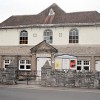“A small grey village rather like Cornwall” is how some writers have described Swyre, in its picturesque and rather privileged position near the coast in West Dorset. Swyre in fact lies about half a mile inland from the coast path just beyond the western end of Chesil beach, on the B3157 roughly midway between Bridport and Abbotsbury. It is a settlement of the distinctly linear type, which has grown up along a narrow unclassified lane linking the coast road with the main A35 road to Bridport from Dorchester.
The allusion of Cornwall probably arises from the colour and texture of the cottages and houses which, unusually are confined to the west side of the main street and are a curious mix of the old, modernised old, and the modern. At the southern end are situated the Manor Farm and Holy Trinity Church.
This building is of stone in the Early English style. Holy Trinity was originally built in 1505, and is therefore Tudor and around 200 years later than many other churches in the county. It is rather plain and unadorned building of which only the tower and the chancel arch survive from the 16th century. However, the entire remainder of the church was re-built in 1863, a time when many other parish churches were rebuilt.
The Dorset History Centre holds the baptism registers from 1587/8 to 1998, marriage registers from 1588 to 1926, burial registers 1588 to 2001 (there is a gap in the records between 1812-1814) and the register of banns 1754 to 1915. The Bishop’s transcripts date from 1732 and there are overseer’s accounts 1601 to 1667 and from 1722 to 1837. The Parish of Swyre covers an area of 1081 acres, and had a population of 154 in 1891. The area around the church is a conservation area and some adjoining agricultural land was allotted to the churchyard in 2002.
Of the Church’s Rectors, there are no surviving records before 1297. It was at this time that one John de Candel was the incumbent, but the most distinguished Rector of Swyre was probably the noted Dorset historian John Hutchins. Hutchins was instituted to the living in 1729, and is noted for having repaired the chancel at his own expense during the period of his ministry.
Inside the church can be seen some early 16th century brasses commemorating the Russells, a Dorset merchant family and the principal land owning family associated with Swyre. John Russell rose to be a courtier in an unusual way. In 1506 a ship bearing the daughter of the king and queen of Castille ran aground at Weymouth in a storm. As John Russell could speak Spanish, he was called upon to act as interpreter for the Princess and her husband, Archduke Phillip of Austria. He then accompanied the royal couple to the court of Henry VII at Windsor, where he came to the notice of the king. Henry made Russell a courtier, from where he rose to other positions of high standing over the next thirty years.
Today Holy Trinity Church stands within a broad rectangular churchyard, bordered and well enclosed by mature trees. Access from the road is via either of two gates in the stone wall at the tower (west) end of the church. The visitor will notice that the majority of headstones date from the late 18th and early 19th centuries, and in most instances their inscriptions are entirely obliterated by lichen. One very curious feature of these headstones is that there are two to be seen broken clean in two, as if deliberately struck with a sledgehammer in an act of desecration. Many of the grave-slabs too, are in a ruinous and pitted condition.
Unusually, the church has on display inside a ground plan showing the positions of the graves, which are numbered to correspond with a list of names of people buried in the ground. This document is kept on a lectern near the tower, a copy of which is also held by the Dorset History Centre in Dorchester.



